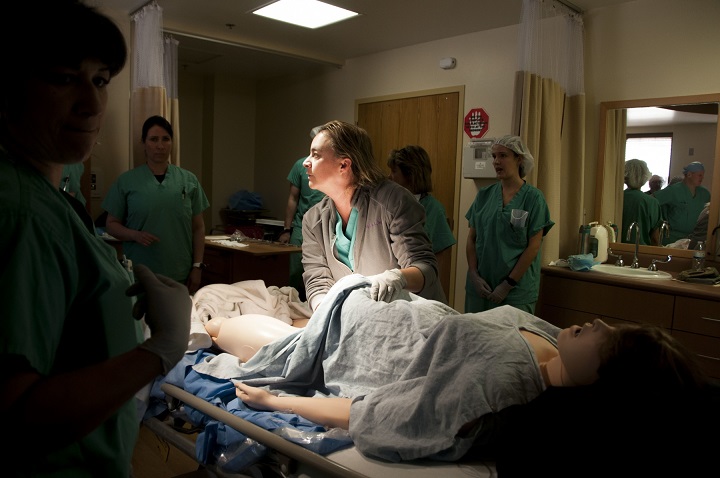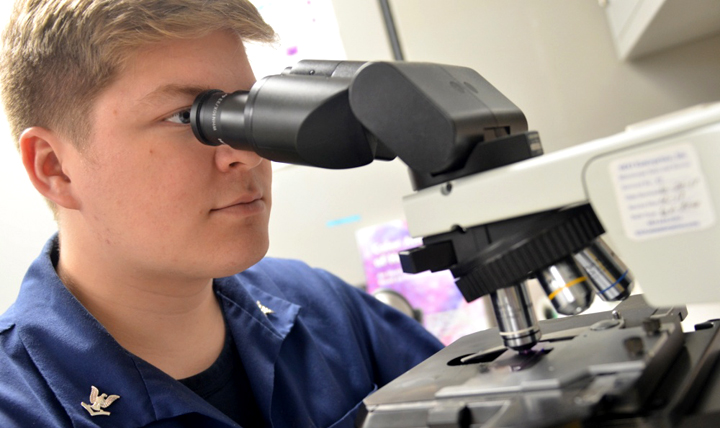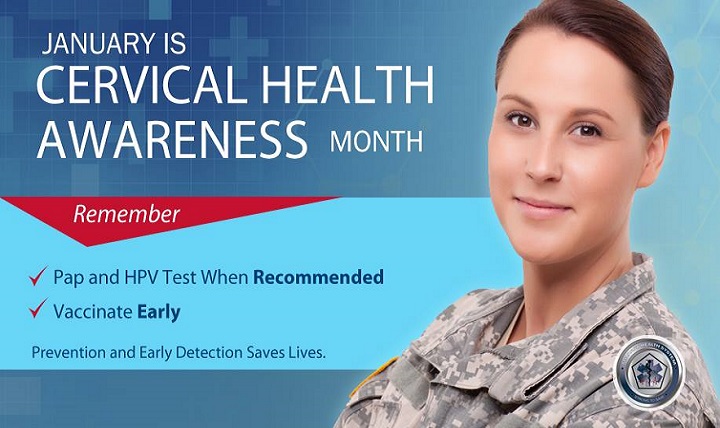
‘Strong progress’ in decreasing death from breast cancer

Air Force Lt. Col. Michelle Nash is joined by her husband and three of her four children at the Think Pink Fun Run, a breast cancer awareness event held earlier this month at the U.S. Air Force Academy, Colorado. (Courtesy photo)
Air Force Lt. Col. Michelle Nash calls her breast cancer diagnosis at the age of 40 shocking and unexpected. “I had no family history. I breastfed all four of my children, and that’s a protective factor,” she said. “I didn’t have any lumps or any symptoms that would cause me to think, ‘I should go get that checked out.’” Nash’s breast cancer was diagnosed after a routine mammogram, her first.
A year later, Nash said she’s feeling great and has no regrets about her decision to have reconstructive surgery after a double mastectomy. And she’s become even more passionate about advocating for preventative care such as mammograms.
“Mammograms may be something women hesitate to get because they’re afraid they’ll be unpleasant or even painful,” said Nash, assistant professor and director of operations at the U.S. Air Force Academy Behavioral Sciences and Leadership Department. “But they’re just so important.”
Breast cancer is the most common cancer among women, according to the Centers for Disease Control and Prevention. It’s the No. 1 cause of cancer deaths among Hispanic women, and the second most common cause of cancer deaths among white, black, Asian, and Native women.
According to the CDC’s most recent statistics, approximately 242,500 women in the United States were diagnosed with breast cancer in 2015, and 41,500 women died of the disease. But thanks to improvements in detection and treatment, “more and more breast cancer patients are becoming breast cancer survivors,” said Army Col. Craig Shriver, director of the John P. Murtha Cancer Center at Walter Reed National Military Medical Center in Bethesda, Maryland.
“We’re making strong progress in decreasing death from breast cancer,” he said.
Citing a study that was published October 2017 in the American Cancer Society’s “CA: A Cancer Journal for Clinicians,” Shriver said breast cancer deaths declined 40 percent from 1989 to 2015.
“That’s dramatic,” said Shriver, who’s also an oncology surgeon and a surgery professor at the Uniformed Services University of the Health Sciences in Bethesda.
Shriver said the study showed the number of women diagnosed with breast cancer during this 15-year period didn’t change much. “But our screening programs are better, so we’re able to detect the cancers at an earlier stage, when they’re treatable.”
Also, oncologists have fine-tuned traditional treatment approaches. Genetic testing of breast cancer tumors allows oncologists to treat with chemotherapy only those patients who are most likely to respond to it. Those who aren’t can be given other treatments or put into clinical trials.
“In the past, we’d spend a year or two giving chemotherapy, only to find out the cancer came back anyway,” Shriver said. “Now, we’re not wasting that time.”
Shriver said less-invasive breast cancer surgeries are also on the horizon. For example, in a traditional lumpectomy – also known as a breast-conserving therapy – surgeons remove the tumor and some surrounding normal tissue. Researchers are conducting clinical trials to determine if instead of surgical removal, the tumor can be destroyed while it’s still in the breast with directed laser technology.
“We’re moving more and more toward a day, maybe five years from now, when women with breast cancer will be treated almost exclusively without surgery,” Shriver said. “That would be a great advance.”
Meanwhile, he and other health care experts stress early detection. All women over the age of 20 should do a self-exam monthly and get a physical exam by a health care provider annually, Shriver said. For mammograms, women ages 40 to 44 who are at average risk for breast cancer can choose an annual mammogram after consulting with their health care provider. For women 45 to 55 years old, an annual mammogram is recommended. Women 55 and older can get mammograms annually or every two years, based on provider recommendation. For women who have a family history of breast cancer, the CDC recommends discussing screening frequency with a health care provider.
“We can treat breast cancer patients with fewer side effects and with better, targeted therapies,” Shriver said, “and survival rates are better. But early detection is still the best thing.”
Military Midwives Advance Medicine
Video
10/23/2018

Military midwives assist in advancing military medicine. Capt. Brittany Hannigan uses educational opportunities to bring evidence-based practices to the patient's bedside.
Women’s Health: Taking time for yourself
Article
10/16/2018

The top two causes of death for women are heart disease and cancer
Military midwives as educators
Video
10/15/2018

Within the military, midwives serve as educators. Kwuan Paruchabutr shares how midwives ensure that all medical staff are well trained in women's health care.
Sticks and stones can break bones – and so can osteoporosis
Article
10/11/2018

Steps to take today to build a future of healthy bones
Military Midwives in Leadership Roles
Video
10/5/2018

The duties of certified nurse midwives go far beyond the labor delivery room. Cmdr. Kim Shaughnessy explains how midwives hold leadership positions across the Military Health System and how they help shape women's health policy.
Mammograms recommended for early detection of breast cancer
Article
10/4/2018

A mammogram is a low-dose x-ray used to detect the early stages of breast cancer
Midwives in the Military
Video
10/3/2018

Military midwives are key in the Department of Defense's priority of medical readiness. Army Lt. Col. Danielle Molinar shares ways midwives keep female soldiers ready to deploy.
New simulator preps WBAMC staff for OB emergencies
Article
5/1/2018

The state-of-the-art simulator provides medical staff up to various cutting-edge training scenarios
Getting tested for STIs is an 'important part of sexual health'
Article
4/26/2018

Chlamydia and gonorrhea are two of the most common sexually transmitted infections in the United States. Taking preventive steps, like getting tested and practicing safe sex, can help reduce risk of infection or spreading the infection to others.
Fort Belvoir corpsman comes through for moms
Article
4/20/2018

Striving to empower, lactation consultants critical for mothers, babies
The fight against cervical cancer
Article
1/24/2018

Learn about two weapons that can stop this cancer in its tracks
January is Cervical Cancer Awareness Month
Article
1/18/2018

Cervical cancer deaths have decreased by more than 50 percent due to regular screening tests that detect abnormalities before cancer develops
Cold weather injuries during deployments, July 2012 – June 2017
Infographic
1/18/2018

This infographic documents cold weather injuries during deployments for the July 2012 – June 2017 cold seasons.
Complications and Care Related to Pregnancy, Labor and Delivery among Active Component Service Women U.S. Armed Forces, 2012 – 2016
Infographic
1/5/2018

This analysis provides an update on pregnancy complications and characterizes the counts, rates, and trends of several specific pregnancy complications.
Gestational diabetes among pregnant service members, active component, U.S. Armed Forces 2012 – 2016
Infographic
1/5/2018

This infographic documents the incidence and prevalence of gestational diabetes pregnant service members, active component, U.S. Armed Forces, 2012 – 2016.






















.png)











No hay comentarios:
Publicar un comentario